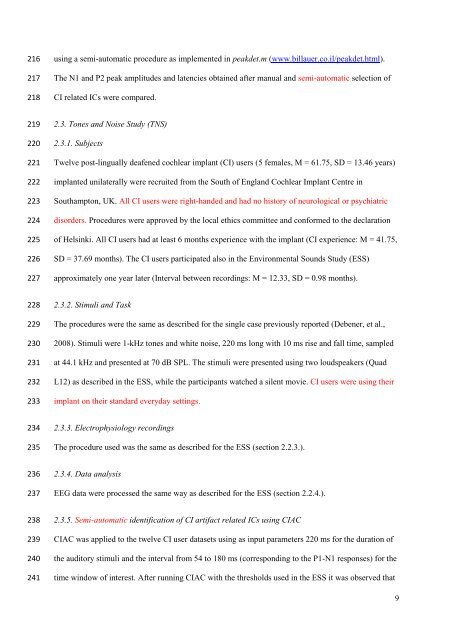Elsevier Editorial System(tm) for Hearing Research Manuscript Draft ...
Elsevier Editorial System(tm) for Hearing Research Manuscript Draft ...
Elsevier Editorial System(tm) for Hearing Research Manuscript Draft ...
Create successful ePaper yourself
Turn your PDF publications into a flip-book with our unique Google optimized e-Paper software.
216<br />
217<br />
218<br />
219<br />
220<br />
221<br />
222<br />
223<br />
224<br />
225<br />
226<br />
227<br />
228<br />
229<br />
230<br />
231<br />
232<br />
233<br />
234<br />
235<br />
236<br />
237<br />
238<br />
239<br />
240<br />
241<br />
using a semi-automatic procedure as implemented in peakdet.m (www.billauer.co.il/peakdet.h<strong>tm</strong>l).<br />
The N1 and P2 peak amplitudes and latencies obtained after manual and semi-automatic selection of<br />
CI related ICs were compared.<br />
2.3. Tones and Noise Study (TNS)<br />
2.3.1. Subjects<br />
Twelve post-lingually deafened cochlear implant (CI) users (5 females, M = 61.75, SD = 13.46 years)<br />
implanted unilaterally were recruited from the South of England Cochlear Implant Centre in<br />
Southampton, UK. All CI users were right-handed and had no history of neurological or psychiatric<br />
disorders. Procedures were approved by the local ethics committee and con<strong>for</strong>med to the declaration<br />
of Helsinki. All CI users had at least 6 months experience with the implant (CI experience: M = 41.75,<br />
SD = 37.69 months). The CI users participated also in the Environmental Sounds Study (ESS)<br />
approximately one year later (Interval between recordings: M = 12.33, SD = 0.98 months).<br />
2.3.2. Stimuli and Task<br />
The procedures were the same as described <strong>for</strong> the single case previously reported (Debener, et al.,<br />
2008). Stimuli were 1-kHz tones and white noise, 220 ms long with 10 ms rise and fall time, sampled<br />
at 44.1 kHz and presented at 70 dB SPL. The stimuli were presented using two loudspeakers (Quad<br />
L12) as described in the ESS, while the participants watched a silent movie. CI users were using their<br />
implant on their standard everyday settings.<br />
2.3.3. Electrophysiology recordings<br />
The procedure used was the same as described <strong>for</strong> the ESS (section 2.2.3.).<br />
2.3.4. Data analysis<br />
EEG data were processed the same way as described <strong>for</strong> the ESS (section 2.2.4.).<br />
2.3.5. Semi-automatic identification of CI artifact related ICs using CIAC<br />
CIAC was applied to the twelve CI user datasets using as input parameters 220 ms <strong>for</strong> the duration of<br />
the auditory stimuli and the interval from 54 to 180 ms (corresponding to the P1-N1 responses) <strong>for</strong> the<br />
time window of interest. After running CIAC with the thresholds used in the ESS it was observed that<br />
9
















